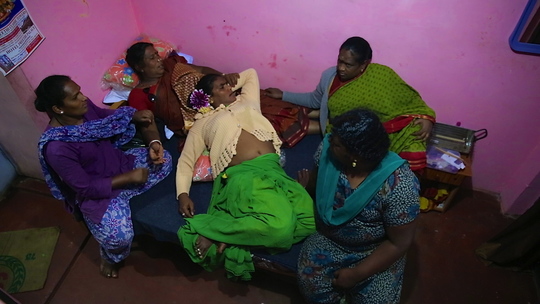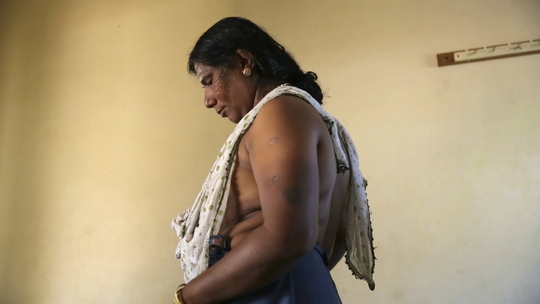Il Terzo Genere. Chimera intellettuale o realtà sociale? Di più…tradizione millenaria in India e in Messico.
“Noi, le Hijira, non siamo nate né donne né uomini. Siamo nate da qualche parte nel mezzo”. “In Juchitan siamo considerate un Terzo genere. Ci sono uomini, donne e Muxes. Io stessa mi sento una dualità: ho la forza di un uomo e la sensibilità di una donna”. Di queste identità sociali parlano due film-documentari usciti negli ultimi mesi. Guru, portrait d’une famille hijra (Guru: ritratto di una famiglia di Hijra), 2015, lungometraggio belga realizzato da Laurie Colson e Axelle Le Dauphin e Muxes cortometraggio di Ivan Olita, 2016.
Muxe e Hijra sono persone nate di sesso maschile che assumono i ruoli sociali e l’abbigliamento femminili, ma che non necessariamente si sottopongono anche alle operazioni chirurgiche o al trattamento ormonale. In entrambi i casi si tratta di identità riconosciute dalle rispettive culture e che affondano le loro radici in una tradizione secolare.
Le Hijra sono menzionate già nei testi sacri Sanscriti più di mille anni fa. Dopo un rituale sacro che prevedeva l’evirazione divenivano veicoli di poteri della divinità Bahuchara Mata, acquisendo a loro volta la facoltà di benedire o dannare le persone. All’epoca dei Sultani e dei Maharaja ricoprivano ruoli chiave a corte. L’arrivo dei colonizzatori inglesi ha spezzato l’equilibrio sociale privando le Hijira del loro potere sacro, marginalizzandole e criminalizzandole. Oggi le Hijra vivono di lavori umili, ma soprattutto chiedendo l’elemosina o come sex workers. Vivono in piccole comunità, che costituiscono la loro famiglia, in cui una assume il ruolo di maestro, il Guru e le altre di Chelas, discepole. Il Guru è anche colui che si prende cura delle necessità delle singole Chelas e della comunità. Il documentario racconta la vita di una queste famiglie à con uno stile narrativo che rende lo spettatore partecipe della vita quotidiana del gruppo. Frutto della scelta dei registi di vivere per 5 mesi insieme alle Hijra.



Il film di Olita ci fa scoprire la bellezza delle Muxe, i loro volti, i loro corpi, i loro vestiti (gli stessi che adottava Frieda Khalo, sebbene appartenesse ad un’altra tradizione indigena) e le loro voci, che raccontano la percezione della loro identità. Le Muxe appartengono alla bimillenaria cultura Zapotec, della regione dello Juchitan. “Qui ognuno – dice un indigeno – ha una storia sulle Muxe, fanno parte del nostro cuore”. Nell’antica lingua Zapotec non esistevano il maschile e il femminile, introdotti dagli spagnoli. Nonostante i Conquistadores questa piccola regione del Messico, che si trova in un istmo, è riuscita a mantenere intatto l’atteggiamento di rispetto e onore verso le Muxe, tanto che a Oaxaca si tiene una grande festa annuale della Muxe, La Vela de las Auténticas Intrépidas Buscadoras del Peligro, o Festival delle Autentiche e Intrepide Cercatrici di Pericolo.
“Nel linguaggio Zapotec Muxes significa sia donna che paura. Penso che tutti abbiamo delle paure. E questa definizione mi piace, perché penso che essere Muxe sia questo. Ti permette di sconfiggere le paure, così da poter poi essere te stesso.”
“Il nostro nome evocava bellezza, coraggio e rettitudine. Noi abbiamo tagliato uno dei nostri organi, e perciò possiamo vivere libere dalla paura della morte. Chi ha paura non sopravvive. La forza è vita. Nella mia prossima vita desidero essere ancora una Hijra e Dio mi è testimone che noi siamo persone forti con un cuore puro.”
On-line
Guru, portrait d’une famille hijra
Muxe
(English text)
Two new films about Hijira and Muxe
In India and Mexico the tradition of a Third Gender dates back to a thousands years ago, when already existed Hijira and Muxes and had a role recognized by society. Now two new films give an insight into these mostly unknown identities. Guru, portrait d’une famille hijra (Guru, portrait of a Hijira family) is a documentary made in 2015 by Belgian Directors Laurie Colson and Axelle Le Dauphin, while Muxes is a short film made in 2016 by Ivan Olita.
Muxe and Hijira are born male, but they live as female, as for their gender role and for their dressing up. Some of them also undergo a surgery or take hormones in order to change their body towards a more feminine aspect.
Proof of existence of Hijira in Indian society can be found in holy books. In ancient times they were regarded as vehicles of the God Bahuchara Mata’s powers after they were emasculated in a holy ritual. After this they too had the power to bless or curse people. When Sultans and Maharaja were in power in India, Hijira held key roles among the aristocracy. British colonization disrupted the traditional culture, so that they lost their holy power and social influence and were then marginalized and criminalized. Nowadays Hijira survive doing poor jobs, bagging or being sex workers. They usually lives in small community which they regard as their families. Every community is led by one of them, the Guru, who is a sort of Master who takes care for all the other members, called Chelas. The documentary tells the story of one of this family in a way that brings the viewer right into Hijiras’ daily life. That was made possible by the choice of the Directors to live with them over a period of 5 months.
The second film talks of Mexican Muxes in a more general way. It focuses on their faces, their bodies, their voices and their clothes, which are the same used by Mexican artist Frida Khalo, even if her local tradition was a different one. In the film we hear Muxes telling us about their identity. They are part of the Zapotec minority, a two-thousands-years old local culture, which can be found in the Juchitan region. Muxes are very well know among the local population and fully accepted. In the ancient Zapotec language there were no masculine of feminine nouns and pronouns, which started to be used after the Spanish colonization. But as the Juchitan is an isthmus, the Zapotec didn’t suffer too much from the new culture and Muxes are still not only accepted but also respected. They are such an important and strong part of the indigenous population that every year they celebrate their gender and social identity in a very big parade, La Vela de las Auténticas Intrépidas Buscadoras del Peligro, the Festival of the Authentic and Brave Risk Seekers.